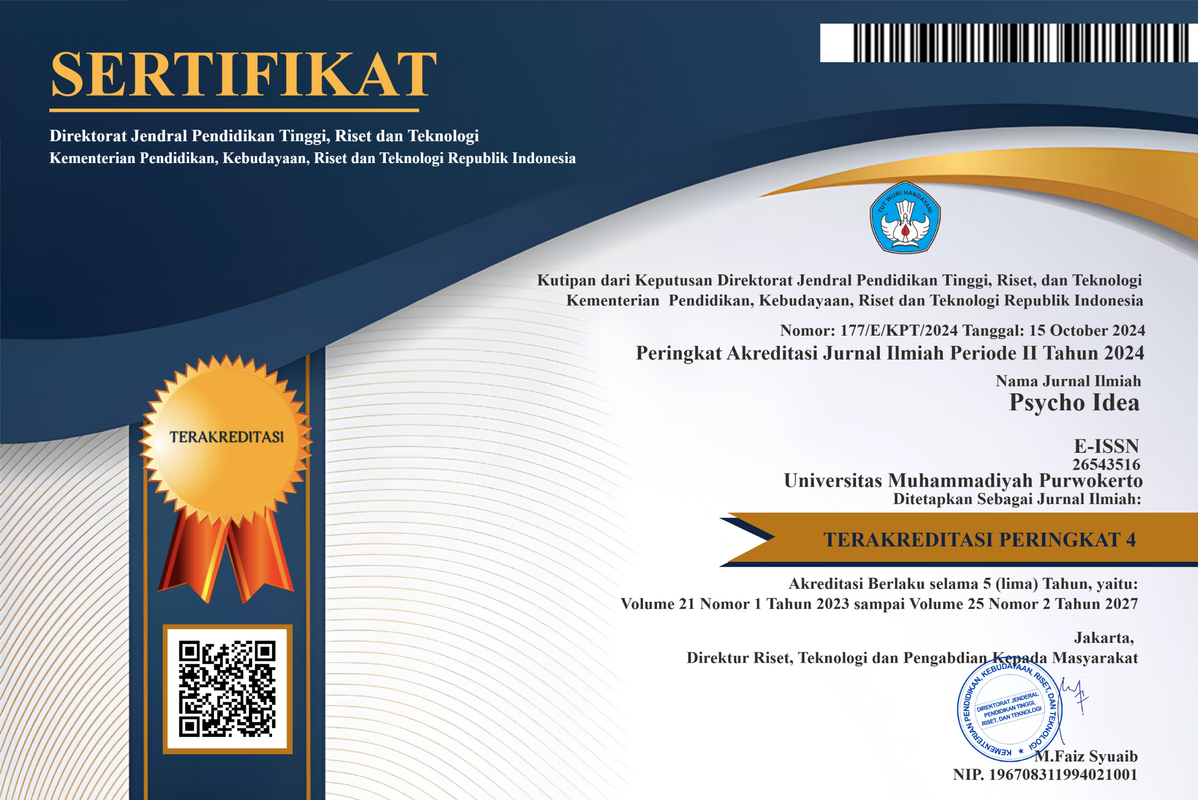Orientasi Masa Depan Pada Remaja Pelaku Tindak Pidana
DOI:
https://doi.org/10.30595/psychoidea.v18i1.5965Keywords:
Remaja, Orientasi masa depan, Pelaku tindak pidanaAbstract
Masa remaja merupakan masa dimana individu sudah mampu merancang dan mempersiapkan masa depannya dengan baik, ditunjang dengan fasilitas dan juga kondisi situasi lingkungan yang mendukung. Remaja pelaku tindak pidana dituntut untuk dapat beradaptasi dan bersosialisasi dengan lingkungan Lembaga Pembinaan yang menekan, monoton dan kaku. Kondisi dan situasi seperti ini, remaja tetap dapat merancang orientasi masa depan meskipun kehidupan yang dijalani berbeda dengan remaja pada umumnya. Metode yang digunakan dalam penelitian ini adalah metode kualitatif dengan pendekatan fenomenologi. Pengambilan data dengan menggunakan wawancara. Penelitian ini dilakukan kepada tiga responden remaja pelaku tindak pidana di LPKA Klas II Tanjung Pati.Hasil penelitian menggambarkan orientasi masa depan ketiga responden, yang berorientasikan kepada pendidikan dan ada juga satu responden yang berorientasikan kepada pekerjaan, dengan cara mengumpulkan informasi dan melakukan persiapan diri. Orientasi masa depan pada ketiga responden dipengaruhi oleh faktor internal dan faktor kontekstual.
References
Ahmad, R. F. (2012). Orientasi Masa Depan Narapidana Remaja. Journal of Social and Industrial Psychology, 1(1). ISSN 2252-6838
Atmasasmita, R. (1995). Kapita Selekta Hukum dan Kriminologi. Bandung. Mandar Maju.
Deri, P. S. (2015). Pengaruh Self Esteem Terhadap Orientasi Masa Depan Bidang Pekerjaan pasa Siswa SMKN 4 Padang.Skripsi. Padang: Universitas Andalas.
Hurlock, E. B. (1994). Psikologi Perkembangan: Suatu Proses Pendekatan Sepanjang Rentang Kehidupan. Edisi 5. Jakarta. Penerbit Erlangga.
Indonesia, P. R. (2014). Undang-Undang Republik Indonesia Nomor 35 Tahun 2014 tentang Perlindungan Anak
Latif, M. A .(2017).Analisis Putusan Hakim Terhadap Anak Pelaku Tindak Pidana Kejahatan Seksual.(Skripsi Terpublikasi).Makasar:Fakultas Syari’ah dan Hukum Universitas Islam Negeri Alaudin Makasar.
McCabe, K. M. & Barnett, D. (2000). The Relation between Familial Factors and the Future Orientation of Urban, African American Sixth Graders. Journal of Child and Family Studies. 9(4). 491 – 508. http://doi.org/10.1023/A:1009474926880
Moustakas, C. E. (1994). Phenomenological reasearch methods. California: Sage Publications Inc.
Nomor, K. M. K. R. I. M. 02-PK. 04.10 Tahun 1990 tentang Pola Pembinaan Narapidana. Tahanan Menteri Kehakiman Republik Indonesia.
Nurmasari, R., Wahyono, H. & Haryono, A. (2016). Peran Status Sosial Ekonomi Orangtua dalam Penyusunan Orientasi Masa Depan Anak. Jurnal Pendidikan. 1 (11). https://dx.doi.org/10.17977/jp.v1i11.8130
Nurmi, J. E. (1991). How do adolescents see their future? a review of the development of future orientation and planning. Developmental Psychologi. 11 (1). https://doi.org/10.1016/0273-2297(91)90002-6
Nurmi, J. E. (1989). Adolescent’s Orientation to the Future: Development of Interest and Plans, and related Attributions and Effect in the Life – Span Context. Helsinki. The Finish Society of Science and Letters.
Seginer, R. (2009). Future Orientation: Developmental and Ecological Perspectives. New York: LCC.
Seginer, R. dan Mahajna, S. (2004). How The Future Orientation of Traditional Israeli Palestinian Girls Links Belief about Women’s and Academic Achievement. Psychology of Women Quarterly. 28. https://doi.org/10.1111/j.1471-6402.2004.00129.x
Susanti, R. (2016). Gambaran Orientasi Masa Depan Remaja dalam Bidang Pekerjaan Ditinjau dari Religiusitas dan Motivasi Berprestasi pada Remaja Desa Sei Banyak Ikan Kelayang. Jurnal Psikologi, Vol. 12, No. 1, Hal. 109-116. ISSN 2407-8786
Trommsdorff, G. (1983). Future Orientation and Socialization. International Journal of Psychology. 18(1–4). 381–406. https://doi.org/10.1080/00207598308247489
Trommsdorff, G. (1986). Future Time Orientation and Its Relevance for Development as Action. Berlin: Springer, 121–136. https://doi.org/10.1007/978-3-662-02475-1_7
Yulianti.dkk. (2009). Gambaran Orientasi Masa Depan Narapidana Remaja Sebelum dan Setelah Pelatihan di Rumah Tahanan Negara Kelas 1 Bandung.Artikel Ilmiah.Vol 10 No. XIX Oktober 2008 – Februari 2009 Hal 97.
Downloads
Published
Issue
Section
License
Authors published in this journal agree to the following terms:
- The copyright of each article is retained by the author (s) without restrictions
- The journal allows the author(s) to retain publishing rights without restrictions
- The author grants the journal the first publication rights with the work simultaneously licensed under the Creative Commons Attribution License, allowing others to share the work with an acknowledgment of authorship and the initial publication in this journal.
- Authors may enter into separate additional contractual agreements for the non-exclusive distribution of published journal versions of the work (for example, posting them to institutional repositories or publishing them in a book), with acknowledgment of their initial publication in this journal
- Authors are permitted and encouraged to post their work online (For example in the Institutional Repository or on their website) before and during the submission process, as this can lead to productive exchanges, as well as earlier and larger citations of published work
- Articles and all related material published are distributed under a Creative Commons Attribution-4.0 International Public License (CC - BY 4.0).
License
Psycho Idea is licensed under a Creative Commons Attribution- 4.0 International Public License (CC - BY 4.0).
You are free to :
Share — copy and redistribute the material in any medium or format
Adapt — remix, transform, and build upon the material for any purpose, even commercially











